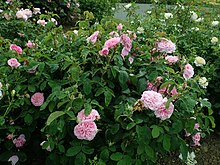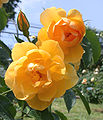English roses

English roses are a cross of various old roses and modern hybrid tea and floribunda roses . The history of the English rose is closely linked to the name of the English breeder David CH Austin . He was inspired by a copy of a book on old roses by George Bunyard and by the lupine breeder and friend of his father, James Baker.
Properties of English roses
The flower shape of the English rose is very similar to the flower of the old rose. There are bowl-shaped and rosette-shaped flowers, often filled with many small petals like a peony , which is why the flower heads tilt to the side in younger plants. English roses have a natural, bush-shaped growth and can reach a height of 1.2 to 1.5 m without support, climbing roses up to 4.5 m. There are also some low varieties that are also suitable as bed roses . English roses have beautiful, bushy foliage.
Since the breeder especially lacked the fragrance of the modern roses, he said
"The aim of breeding English roses was not so much the luminosity of the flower color or even the excessive production of flowers, but the fine charm and fragrance of the individual flowers."
The first English roses
After many attempts, Austin succeeded in 1961 with the rose Constance Spry, the first English rose to combine the desired properties. Constance Spry's parents are the Floribunda rose Dainty Maid from breeder EB Le Grice and the Gallica rose Belle Isis .
The Constance Spry received a lot of attention from lovers of old roses. Austin was not yet satisfied, however, as Constance Spry only bloomed once. In elaborate further attempts, through backcrossing and crossing with other Floribunda roses and old tea hybrids, Austin experimented to get closer to this goal. So from another Floribunda rose from Le Grice Dusky Maiden and the Gallica rose Tuscany in 1967, the second English rose Chianti was created , but it only bloomed once. In 1968, Shropshire Lass was the third English rose to be created by crossing the tea hybrid Madame Butterfly and the Rosa alba Madame Legras de St. Germain . Shropshire Lass is a sturdy rose with a shrub that can grow to eight feet; as a climbing rose even up to 4.5 m. In 1969 the fourth and fifth English Rose Wife of Bath and Canterbury were added. In the same year Austin introduced the name English Rose and founded the Austin rose nursery.
The early stage
- 1970 Chaucer
- 1973 Charles Austin , Lilian Austin , Red Coat
- 1975 Yellow Button
- 1977 The Squire
- 1979 The Reeve
- 1982 Charmian , Cymbeline , Fair Bianca , Hero , Leander , Prospero , Wise Portia
- 1983 Dapple Dawn , Chressida , Lucetta , Mary Rose , Peach Blossom , →, Sir Clough , Tamora
With the two new roses Graham Thomas and Mary Rose , the English roses became known worldwide in 1983. At around the same time, the botanist and rose specialist Michael Marriott joined the Austin company; he took care of systematisation and quality assurance. With around 40,000 crossing attempts per year, this is becoming increasingly important.
- 1984 Belle Story , Bredon , Cardinal Hume , Dove , Heritage , Marry Webb , Wenlock , Windrush
- 1985 Abraham Darby , Emanuel , Hilda Murrell , Sir Walter Raleigh
Systematization
Every year Austin publishes a catalog with its novelties, its English roses and old roses . For some years now, the English roses have been further subdivided in this catalog according to their origin or their parents:
Hybrid old roses
The original English roses have much of the character of the real old roses like Gallica roses and Damascus roses . As with their parents, the colors are delicate tones of pink, crimson, and purple. They have an intense scent. Examples are:
- Barbara Austin
- Gentle Hermione
- Gertrude Jekyll
- LD Braithwaite
- Mary Rose
- Othello
- Wife of Bath
- William Shakespeare
- William Shakespeare 2000
- Lady Salisbury
Leander group
The roses in this group are somewhat more similar in character to modern roses, most of them grow straight upright, as they are mainly derived from hybrids with Leander and tea hybrids . The spectrum of colors is wider than in the first group. The scent also varies more, often the roses in this group smell of tea roses, i.e. sweet and fruity, but sometimes also have a light scent of old roses . Examples are:
- Abraham Darby
- Charles Austin
- Golden Celebration
- Leander
- Pat Austin
- Summer song
- Teasing Georgia
- A Shropshire Lad
- Grace
- Benjamin Britten
- Boscobel
English moschata hybrids
Moschatah hybrids are the result of crossing roses from the first group with Noisette roses . Most of these roses are of lighter growth. The colors are delicate, in pink, yellow, apricot and peach. The scent is very different. Examples are:
- Buttercup , Syn .: Austin's Buttercup
- Evelyn , in Germany: Apricot Parfait
- Graham Thomas
- Heritage
- Lady Emma Hamilton
- The Pilgrim
- Anne Boleyn
English hybrids of the Alba rose
The English hybrid of the Alba rose is the youngest family of English roses. These stand out somewhat from the others due to their wild rose-like growth.
English roses from other growers
Austin himself counts the variety Gruß an Aachen , by the German breeder Philipp Geduldig and presented in 1909, to the English roses. He justifies this as follows:
"It forms a bushy plant [...] with large, bowl-shaped flowers of shimmering pink [...] They are densely filled and in the typical style of old roses, with a lovely silky shimmer and delicious scent. It is also really multiple flowers and [...] very healthy and hardy. "
swell
literature
- David Austin: English Roses - Tradition and Beauty. Cologne 1994, ISBN 3-7701-3267-X
- David Austin: Old Roses & English Roses - Dreams in fragrance and color. Cologne 1993, ISBN 3-7701-3270-X
- David Austin: Shrub Roses & Climbing Roses - With Hybrid Tea and Floribunda Roses. Cologne 1995, ISBN 3-7701-3389-7
- David Austin: The magic of English roses. Munich 2000, ISBN 3-405-15770-6
Individual evidence
- ↑ David Austin, Rose Handbook 2007/8, p. 3
- ^ David CH Austin OBE. Retrieved June 20, 2019 .
- ↑ David Austin Rose Nursery Limited (ed.): Rose Handbook 2018/2019 . Albrighton 2018, p. 248 .
- ↑ David Austin, Alte Rosen & Englische Rosen , p. 164




















